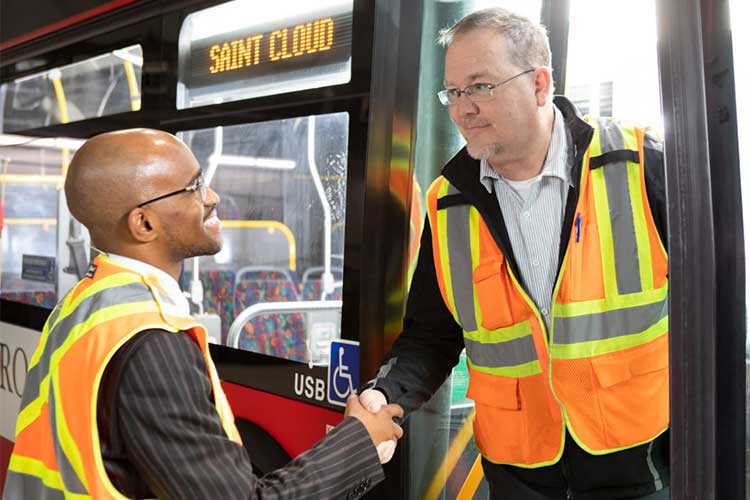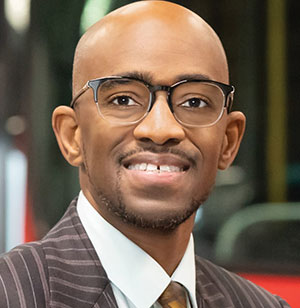The 2023 CEOs Who “Get It”

Ryan I. Daniel
CEO
St. Cloud Metropolitan Transit Commission
St. Cloud, MN

The St. Cloud Metropolitan Transit Commission, also known as Metro Bus, operates in central Minnesota, with the mission to provide safe, friendly and reliable public transportation services. Metro Bus has three primary divisions: Fixed Route, Dial-a-Ride paratransit and Northstar Link Commuter Bus service operated on behalf of three counties. Metro Bus and its 160 employees transport over 1 million passengers annually.
Describe your personal journey to becoming a CEO who “gets it.” What experiences or lessons brought you to where you are now?

I started my career in public transportation as a bus operator for the New York City Transit Authority. Along the way, I spent two years as a training manager for the Central Ohio Transit Authority, where I supported and operationalized the mission of training and safety by designing job-related and safety-focused learning systems in support of COTA’s workforce. Washington Metro Area Transit Authority was my next transit system, where I served as the manager of bus service. At WMATA, I directed the overall functions for day-to-day bus service delivery, trained staff and managed performance. I managed standards for improving safety culture, employee development and labor relations. These three transit authorities prepared me to be the CEO of St. Cloud Metropolitan Transit Commission and to navigate a pandemic no one knew was on the horizon. In New York City as a bus operator, I was part of a team of over 5,000 bus operators, where our goal was to safely move over 2 million people a day, 365 days a year, without accident or incident, no matter what the weather conditions were. That taught me the importance of being safe and that safety had no days off.
What is the biggest obstacle to safety at your organization? How do you work to overcome it?
Complacency is the biggest obstacle. We find that employees get too relaxed within their roles, and this is the time we must redouble our efforts with training and awareness. In 2016, we initiated new safety improvements that reduced preventable incidents by 55% from 2017 through 2021. The development and implementation of the Metro Bus Safety Program was the key management factor in improving safety results. Elements of the Metro Bus Safety Program include updating systems used for tracking, investigating and retraining as a result of accidents or incidents. The various programs and initiatives that are in place to help aid in overcoming complacency include annual refresher training, which is mandatory for all employees; the creation of a safety committee, which consists of employees from various departments in the organization; and safety messages displayed throughout all our facilities, which serve as reminders to all employees that safety is No. 1. The employees are also honored on the achievement of preset milestones, for going the distance without an incident.
Why is safety a core value at your organization?
Citizens who use public transportation in central Minnesota consider their mode of transit a personal asset for them to get to work, school, home and even for leisure purposes, as it assists in their life’s journey. As a result of being an asset, and having the trust of the community, safety is paramount in maintaining our position in the eyes of our riders, as well as our employees, thus the reason safety is a core value. We can have top-of-the-line buses with all the bells and whistles, but if they pose a risk to our bus operators, customers or community, we have done a disservice. Therefore, we keep safety at the forefront of our day-to-day operation, where it is measured, to ensure success.
How do you instill a sense of safety in employees on an ongoing basis?
A favorite saying of mine is, “You have to inspect what you expect, or employees will not take what you are saying seriously!” Therefore, we measure our incidents and reward all operators every time they collectively go 30 days without a preventable incident. We listen to our team through regular pulse surveys, suggestion boxes, committee meetings and act on all items that can enhance the service delivery experience, for both internal and external stakeholders. Our training and safety department, along with the safety committee, are leading top-level factors in making sure employees are given the tools they need to be safe and successful in their various roles. We also have a digital safety board that keeps a running count of the time since our last preventable incident. It is in a uniquely visible location between our Fixed Route and Dial-a-Ride garages. This keeps safety as a primary focus for all staff as they go about their duties. Our safety reporting system also provides employees with a tool to directly submit any issues or concerns they perceive as a safety hazard as they perform their daily tasks. Employees are continually reminded to stay focused on safety and report any incident they feel jeopardizes that commitment.
How does your organization measure safety? What are the leading indicators that show you how safe your organization is, and where do you see room for improvement?
Two of the many ways our organization measures safety is by looking at the number of preventable incidents and the mean distance between failures. MDBF measures our fleet’s mechanical reliability and success of preventative maintenance efforts. A higher MDBF value indicates we are improving the mechanical performance of our fleet, and thus providing better service reliability for our customers. This data is monitored on a monthly basis. Our leading indicators are audits and field inspections. As a result, we implemented a digital safety board, displaying the time since the last preventable incident for any in-service vehicle in real time. This encourages the operators to be mindful of their training and to not have an incident so the clock is not reset. If I had to select one area to improve upon, it would be reducing our total number of incidents in a year. We will remain faithful with our training and reinforcing these values, as we continue our downward trend toward the ultimate goal of zero incidents.
What role does off-the-job safety play in your organization’s overall safety program? What types of off-the-job safety and health programs does your organization offer to employees?
Off-the-job safety is still overall on-the-job safety from our perspective, therefore it plays a critical role. We cover 100% of our employee’s health benefits, with the hope they will take exceptional care of their body, mind and spirit. This benefit should afford each team member to bring their best selves to work each day. If an employee is indulging in illicit drugs off the job and experience side effects while at work, that is a liability to us. The world has seen an increase in mental health issues. We offer and encourage employees to use mental health resources. Our employee assistance program includes:
- Self-care mobile apps to help with insomnia, anxiety, depression, substance use, obsessive compulsive disorder and chronic pain
- Health and wellness articles, guides, webinars and podcasts
- Online assistance with elder care, child care and other family-life resources
- Help with teen and adolescent issues, including eating disorders and relationships
- Tips on parenting and grandparenting
- 24/7 phone consultation with licensed mental health professionals and referrals to supportive resources
- Ongoing personal coaching sessions with scheduled telephonic appointments, and more.
Metro Bus wants our employees to be authentic outside of work, and bring that same person to work, so we support a balanced, healthy and safe lifestyle.
What have you done to support employee mental health and well-being within your organization?
The mental and emotional health of our employees are of utmost importance. Metro Bus established an employee well-being program, featuring a committee comprising a cross-section of employees representing all departments who plan events, recommend ideas, provide well-being resources and coordinate initiatives. The well-being committee is empowered to fulfill the mission to “foster an environment that contributes to our employees’ social, financial, physical and emotional well-being.” The committee meets monthly to plan and develop programs to encourage employee engagement, fitness/nutrition practices, and other activities to promote employee morale, camaraderie and overall well-being. These programs provide access to well-being resources such as the employee assistance program, a library of materials for check out, and ongoing information related to mental/emotional health and how our employees can thrive. Some events our well-being committee has hosted include the Annual Fitness Challenge, Ugly Holiday Sweater Contest, Employee Softball Challenge and Casual Fridays. I must say, the Dunk Tank initiative is my favorite event. It is always a treat to see who wants to dunk the CEO – safely that is!
Post a comment to this article
Safety+Health welcomes comments that promote respectful dialogue. Please stay on topic. Comments that contain personal attacks, profanity or abusive language – or those aggressively promoting products or services – will be removed. We reserve the right to determine which comments violate our comment policy. (Anonymous comments are welcome; merely skip the “name” field in the comment box. An email address is required but will not be included with your comment.)


